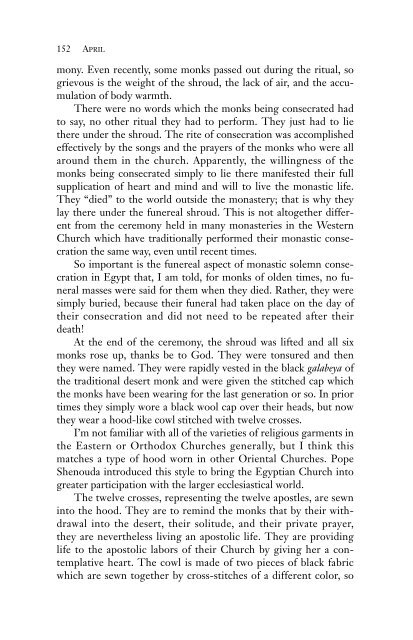Journey Back to Eden.pdf - St Mark Coptic Orthodox Church Chicago
Journey Back to Eden.pdf - St Mark Coptic Orthodox Church Chicago
Journey Back to Eden.pdf - St Mark Coptic Orthodox Church Chicago
You also want an ePaper? Increase the reach of your titles
YUMPU automatically turns print PDFs into web optimized ePapers that Google loves.
152 APRILmony. Even recently, some monks passed out during the ritual, sogrievous is the weight of the shroud, the lack of air, and the accumulationof body warmth.There were no words which the monks being consecrated had<strong>to</strong> say, no other ritual they had <strong>to</strong> perform. They just had <strong>to</strong> liethere under the shroud. The rite of consecration was accomplishedeffectively by the songs and the prayers of the monks who were allaround them in the church. Apparently, the willingness of themonks being consecrated simply <strong>to</strong> lie there manifested their fullsupplication of heart and mind and will <strong>to</strong> live the monastic life.They “died” <strong>to</strong> the world outside the monastery; that is why theylay there under the funereal shroud. This is not al<strong>to</strong>gether differentfrom the ceremony held in many monasteries in the Western<strong>Church</strong> which have traditionally performed their monastic consecrationthe same way, even until recent times.So important is the funereal aspect of monastic solemn consecrationin Egypt that, I am <strong>to</strong>ld, for monks of olden times, no funeralmasses were said for them when they died. Rather, they weresimply buried, because their funeral had taken place on the day oftheir consecration and did not need <strong>to</strong> be repeated after theirdeath!At the end of the ceremony, the shroud was lifted and all sixmonks rose up, thanks be <strong>to</strong> God. They were <strong>to</strong>nsured and thenthey were named. They were rapidly vested in the black galabeya ofthe traditional desert monk and were given the stitched cap whichthe monks have been wearing for the last generation or so. In priortimes they simply wore a black wool cap over their heads, but nowthey wear a hood-like cowl stitched with twelve crosses.I’m not familiar with all of the varieties of religious garments inthe Eastern or <strong>Orthodox</strong> <strong>Church</strong>es generally, but I think thismatches a type of hood worn in other Oriental <strong>Church</strong>es. PopeShenouda introduced this style <strong>to</strong> bring the Egyptian <strong>Church</strong> in<strong>to</strong>greater participation with the larger ecclesiastical world.The twelve crosses, representing the twelve apostles, are sewnin<strong>to</strong> the hood. They are <strong>to</strong> remind the monks that by their withdrawalin<strong>to</strong> the desert, their solitude, and their private prayer,they are nevertheless living an apos<strong>to</strong>lic life. They are providinglife <strong>to</strong> the apos<strong>to</strong>lic labors of their <strong>Church</strong> by giving her a contemplativeheart. The cowl is made of two pieces of black fabricwhich are sewn <strong>to</strong>gether by cross-stitches of a different color, so


